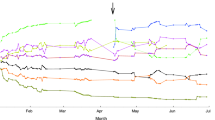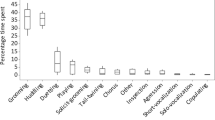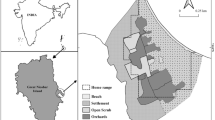Abstract
Sooty mangabeys are terrestrial monkeys exhibiting female philopatry and male dispersal. Studies in captivity as well as in the wild have found that adult females form linear dominance hierarchies. However, while captive studies found no evidence for a matrilineal social system, a previous study in Taï National Park, Ivory Coast, suggested that relatedness could influence both dominance rank and affiliation pattern among adult females. Here I test whether the dominance rank, coalitionary behavior, and affiliative behavior of juveniles in a group of free-ranging mangabeys in the Taï National Park are in accordance with a matrilineal, individual, or age-related dominance system. I found that juvenile females' dominance ranks remained stable over time and were highly correlated with the dominance ranks of their mothers, whereas juvenile males' dominance ranks were initially correlated with the ranks of their mothers, but showed greater instability with increasing age. Moreover, coalitions occurred mainly between juveniles and animals that were close in rank, including their mothers and siblings. Finally, juvenile females associated and groomed preferentially with close-ranking juvenile and adult females. Juvenile males showed similar preferences in affiliation with adult females, but when associating with juvenile males, they preferred peers. The observed social behavior of free-ranging juvenile sooty mangabeys resembled the social behavior described for juveniles of many matrilineal primate species.


Similar content being viewed by others
References
Altmann J (1974) Observational study of behaviour: sampling methods. Behaviour 49:227–265
Bekoff M (1977) Mammalian dispersal and the ontogeny of distinctive phenotypes. Am Nat 111:715–732
Benneton C (2002) Les tactiques reproductrices des mangabeys noirs dans le parc national de Taï, en Cote d'Ivoire. Master thesis. Department of Primates Ethology, Universite de Strasbourg
Bernstein IS, Ehardt CL (1985a) Agonistic aiding: kinship, rank, age and sex influences. Am J Primatol 8:37–52
Bernstein IS, Ehardt CL (1985b) Age–sex class differences in the expression of agonistic behaviour in rhesus monkey (Macaca mulatta) groups. J Comp Psychol 99:114–132
Borries C (1993) Ecology of female social relationships: Hanuman langurs (Presbytis entellus) and the van Schaik model. Folia Primatol 61:21–30
Borries C, Sommer V, Srivastava A (1991) Dominance, age, and reproductive success in free-ranging female Hanuman langurs (Presbytis entellus). Int J Primatol 12:231–257
Chapais B (1988) Experimental matrilineal inheritance of rank in female Japanese macaques. Anim Behav 36:1025–1037
Chapais B, Girard M, Primi G (1991) Non-kin alliances and the stability of matrilineal dominance relations in Japanese macaques. Anim Behav 41:481–491
Cheney DL (1977) The acquisition of rank and the development of reciprocal alliances among free-ranging immature baboons. Behav Ecol Sociobiol 2:303–318
Cheney DL (1978) Interactions of immature male and females baboons with adult females. Anim Behav 26:389–408
Cheney DL (1983). Extra-familial alliances among vervet monkeys. In: Hinde RA (ed) Primate social relationships: an integrated approach. Blackwell, Oxford
Colvin J (1985) Breeding-season relationships of immature male rhesus monkeys with females. I. Individual differences and constraints on partner choice. Int J Primatol 6:261–287
Cords M (1988) Resolution of aggressive conflicts by immature male long-tailed macaques. Anim Behav 36:1124–1135
Crockett CM, Pope TR (1993) Consequences of sex differences in dispersal for juvenile red howler monkeys. In: Pereira ME, Fairbanks LA (eds) Juvenile primates. Oxford University Press, New York, pp 104–118
de Vries H (1995) An improved test of linearity in dominance hierarchies containing unknown relationships. Anim Behav 50:1375–1389
de Vries H, Netto WL et al (1993) Matman: a program for the analysis of sociometric matrices and behavioral transition matrices. Behaviour 125(3–4):157–175
Dittus WPJ (1977) The social regulation of population density and age–sex distribution in the toque monkey. Behaviour 63:281–322
Ehardt CL (1988a) Absence of strongly kin-preferential behavior by adult female sooty mangabeys (Cercocebus atys). Am J Phys Anthropol 76:233–243
Ehardt CL (1988b) Affiliative behavior of adult sooty mangabeys (Cercocebus atys). Am J Primatol 15:115–127
Fairbanks LA (1990) Reciprocal benefits of allomothering for female vervet monkeys. Anim Behav 40:553–562
Fairbanks LA (1993) Juvenile vervet monkeys: establishing relationships and practicing skills in the future. In: Pereira ME, Fairbanks LA (eds) Juvenile primates. Oxford University Press, New York, pp 211–227
Fairbanks LA, McGuire MT (1985) Relationships of vervet mothers with sons and daughters from one to three years of age. Anim Behav 7:27–38
Gust DA (1995a) Moving up the dominance hierarchy in young sooty mangabeys. Anim Behav 50:15–21
Gust DA (1995b) Sooty mangabeys Cercocebus torquatus atys: a little known primate species. Afr Primates 1(2):51–54
Gust DA, Gordon TP (1991) Female rank instability in newly formed groups of familiar sooty mangabeys (Cercocebus torquatus atys). Primates 32(4):465–471
Gust DA, Gordon TP (1994) The absence of a matrilineally based dominance system in sooty mangabeys, Cercocebus torquatus atys. Anim Behav 47:589–594
Gust DA, Gordon TP, Brodie AR, Mcclure HM (1992). Behavioral and physiological response of juvenile sooty mangabeys to reunion with their mothers following a year's absence. Dev Psychobiol 25(8):613–622
Hemelrijk CK (1990) Models and tests for reciprocity, unidirectionality and other social interaction patterns at group level. Anim Behav 39(6):1015–1025
Hemelrijk CK (1994) Support for being groomed in long-tailed macaques, Macaca fascicularis. Anim Behav 48:479–481
Hemelrijk CK, Ek A (1991) Reciprocity and interchange of grooming and “support” in captive chimpanzees. Anim Behav 41:923–935
Horrocks J, Hunte W (1983) Maternal rank and offspring rank in vervet monkeys: an appraisal of the mechanisms of rank acquisition. Anim Behav 31:772–782
Hrdy S, Hrdy DB (1976) Hierarchical relations among female hanuman langurs (Presbytis entellus). Science 193:913–915
Johnson JA (1987) Dominance rank in juvenile olive baboons, Papio anubis: The influence of gender, size, maternak rank and orphaning. Anim Behav 35:1694–1708
Kaplan J (1977) Fight interference in free-ranging rhesus monkeys. Am J Phys Anthropol 47:279–288
Kawai M (1958) On the system of social ranks in a natural troop of Japanese monkeys (1): Basic and dependent rank. Primates 1:111–148
Kawamura S (1965) Matriarchal social ranks in the Minoo-B group: a study of Japanese monkeys. In: Imanishi K, Altmann SA (eds) Japanese monkeys: a collection of translations. Emory University Press, Atlanta, pp 105–112
Koenig A (2000) Competitive regimes in forest-dwelling Hanuman langur females (Semnopithecus entellus). Behav Ecol Sociobiol 48:93–109
Kurland JA (1977) Kin selection in the Japanese monkey. Contributions to primatology, vol 12. Karger, Basel
Lee PC (1979) Competition, dominance and the acquisition of rank in juvenile yellow baboons (Papio cynocephalus). Anim Behav 27:576–585
Marsden HM (1968) Agonistic behaviour of young rhesus monkeys after changes induced in the social rank of their mothers. Anim Behav 16:38–44
Mitani M (1991) Niche overlap and polyspecific associations among sympatric cercopithecids in the Campo Animal Reserve, Southwestern Cameroon. Primates 32(2):137–151
Nikolei J, Borries C (1997) Sex differential behavior of immature Hanuman langurs (Presbytis entellus) in Ramnagar, South Nepal. Int J Primatol 18:415–437
O'Brien T, Robinson, JG (1993) Stability of social relationships in female wedge-capped capuchin monkeys. In: Pereira ME, Fairbanks LA (eds) Juvenile primates. Oxford University Press, New York, pp 197–210
Pereira ME (1988a) Effects of age and sex on inter-individual spacing behaviour in juvenile savannah baboons (Papio c. cynocephalus). Anim Behav 36:184–204
Pereira ME (1988b) Agonistic interactions of juvenile savannah baboons. I. Fundamental features. Ethology 79(3):195–217
Pereira ME (1989) Agonistic interactions of juvenile savannah baboons. II. Agonistic support and rank acquisition. Ethology 80:152–171
Pereira ME (1992) The development of dominance relations before puberty in cercopithecine societies. In: Gray P, Silverberg J (eds) Aggression and peacefulness in humans and other primates. Oxford University Press, Oxford, pp 117–149
Pereira ME, Altmann J (1985) Development of social behavior in free-living nonhuman primates. In: Watts ES (ed.) Nonhuman primate models for human growth and development. Alan R. Liss, New York, pp 217–309
Pereira ME, Leigh SR (2003) Modes of primate development. In: Kappeler PM, Pereira ME (eds) Primate life histories and socioecology. University of Chicago Press, Chicago, pp 149–176
Rajpurohit LS, Sommer V (1993) Juvenile male emigration from natal one-male troops in Hanuman langurs. In: Pereira ME, Fairbanks LA (eds) Juvenile primates. Oxford University Press, New York, pp 86–103
Range F, Noë R (2002) Familiarity and dominance relations in female sooty mangabeys in the Taï National Park. Am J Primatol 56:137–153
Range F, Noë R (2005) Can simple rules account for the pattern of triadic interactions in juvenile and adult female sooty mangabeys? Anim Behav 69:445–452
Sade DS (1967) Determinants of dominance in a group of free-ranging rhesus monkeys. In: Altmann S (ed) Social communication among primates. University of Chicago Press, Chicago, pp 99–114
Seyfarth RM (1977) A model of social grooming among adult female monkeys. J Theor Biol 65:671–698
Silk JB, Samuels A, Rodman P (1981) The influence of kinship, rank, and sex on affiliation and aggression between adult female and immature bonnet macaques (Macaca radiata). Behaviour 78:111–137
Silk JB, Seyfarth RM, Cheney DL (1999) The structure of social relationships among female savanna baboons in Moremi Reserve, Botswana. Behaviour 136:679–703
Sommer V, Rajpurohit LS (1989) Male reproductive success in harem troops of hanuman langurs (Presbytis entellus). Int J Primatol 10:293–317
van Hooff JARAM, Wensing JAB (1987) Dominance and its behavioural measures in a captive wolf pack. In: Frank H (ed) Man and wolf. Junk Publishers, Dordrecht, pp 219–252
Walters JR (1980) Interventions and the development of dominance relationships in female baboons. Folia Primatol 34:61–89
Walters JR (1981) Inferring kinship from behaviour: maternity determinants in yellow baboons. Anim Behav 29:126–136
Acknowledgements
I thank the Ministère de la Recherche Scientifique and the Ministère de l'Agriculture et des Ressources Animales of Cote d'Ivoire for permission to conduct my research in the Taï National Park. I am grateful to the Taï Monkey Project, the Centre Suisse de Recherches Scientifiques, and the staff of the Centre de Recherche en Ecologie research station in Taï for logistical support. I was supported by the “DAAD Doktorandenstipendiums im Rahmen des gemeinsamen Hochschulsonderprogramms III von Bund und Laendern.” Richard Peho and Gerard Gha provided invaluable assistance in the field by locating the study group and by collecting data. I thank the members of the Taï Monkey Project for support in the field and R. Seyfarth, D. Cheney, A.H. Korstjens, T. Bugnyar, L. Huber, M.E. Pereira, and an anonymous reviewer for comments on earlier drafts of the manuscript.
Author information
Authors and Affiliations
Corresponding author
Additional information
Communicated by J. Setchell
Rights and permissions
About this article
Cite this article
Range, F. Social behavior of free-ranging juvenile sooty mangabeys (Cercocebus torquatus atys). Behav Ecol Sociobiol 59, 511–520 (2006). https://doi.org/10.1007/s00265-005-0076-x
Received:
Revised:
Accepted:
Published:
Issue Date:
DOI: https://doi.org/10.1007/s00265-005-0076-x




